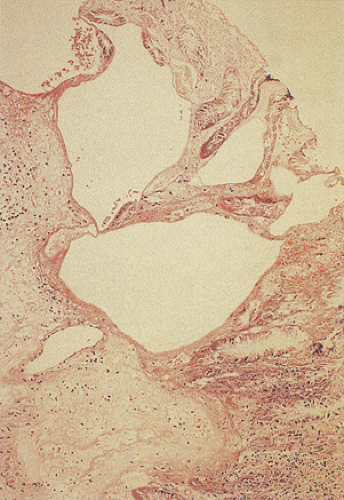Benign Lesions Presenting Clinically as Masses
Various polyp types occur in the small intestine including lesions normally thought of as polyps, such as adenomas or Peutz-Jeghers polyps, as well as other lesions presenting as polypoid masses (Table 6.57). Most polypoid lesions remain asymptomatic and are detected either endoscopically or radiographically. Symptomatic lesions cause bleeding, obstruction, or intussusception. Uncommonly, the whole GI tract, including the small intestine, is affected by a polyposis syndrome, including juvenile polyposis and Peutz-Jeghers syndrome (see Chapter 12).
 FIG. 6.237. Histology of pneumatosis. Figure shows variably sized, air-filled cysts in a mucosal biopsy. |
Inflammatory polyps assume two major forms: Those associated with inflammatory bowel disease (see Chapter 11) and inflammatory fibroid polyps (IFPs). IFPs develop in all age groups and usually arise in the stomach. The small intestine represents the second most common site of origin. Lesions in the small bowel present with intussusception (648), chronic diarrhea, or obstruction. These lesions are inflammatory
reactive proliferations of CD34+ perivascular cells (649). The pathologic features (Fig. 6.239) of this lesion are extensively discussed in Chapter 4.
reactive proliferations of CD34+ perivascular cells (649). The pathologic features (Fig. 6.239) of this lesion are extensively discussed in Chapter 4.
Stay updated, free articles. Join our Telegram channel

Full access? Get Clinical Tree








